Fungicide seed treatments help to reduce losses caused by seed transmitted and soilborne fungal diseases of wheat. Some systemic seed treatment products contain a fungicide and an insecticide and offer additional protection against fall season foliar diseases and insects such as aphids which also transmit barley yellow dwarf virus.
Common bunt, also known as stinking smut (Figure 1) is one of several fungal diseases of wheat that result from contaminated or infected seed. Other diseases include loose smut (Figure 2), ergot (Figure 3), root and seedling diseases resulting from Fusarium-infected wheat seed (Figure 4) and black point (Figure 5).
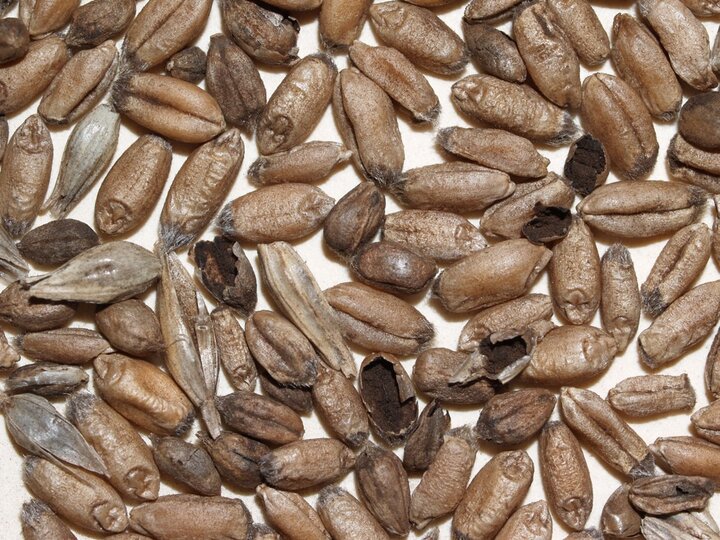
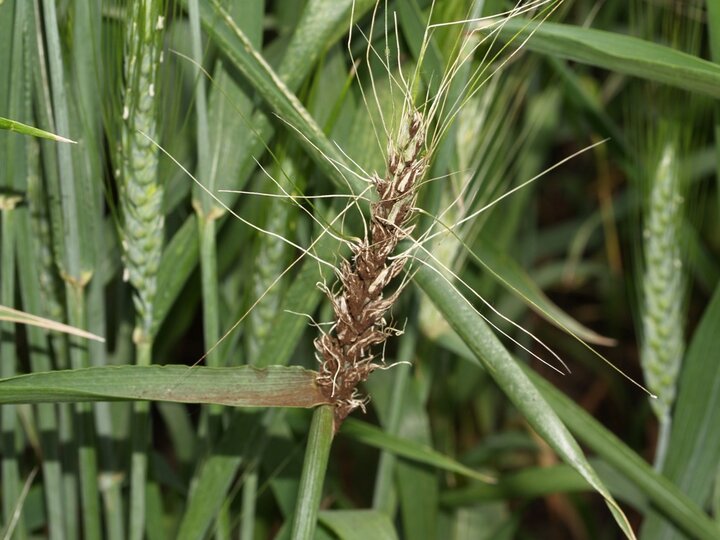
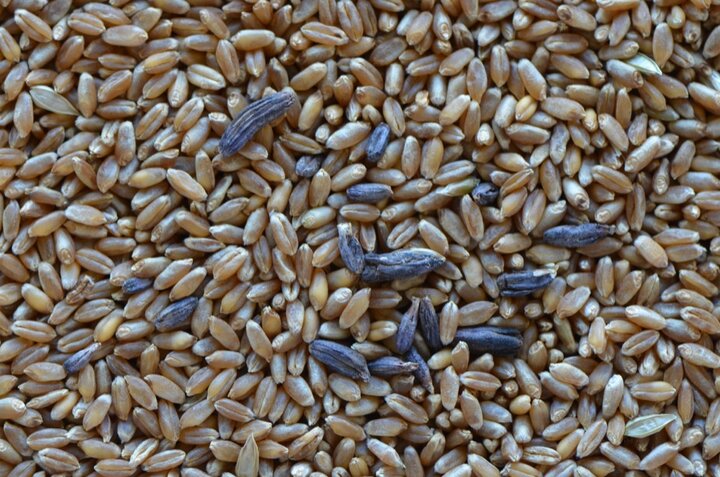
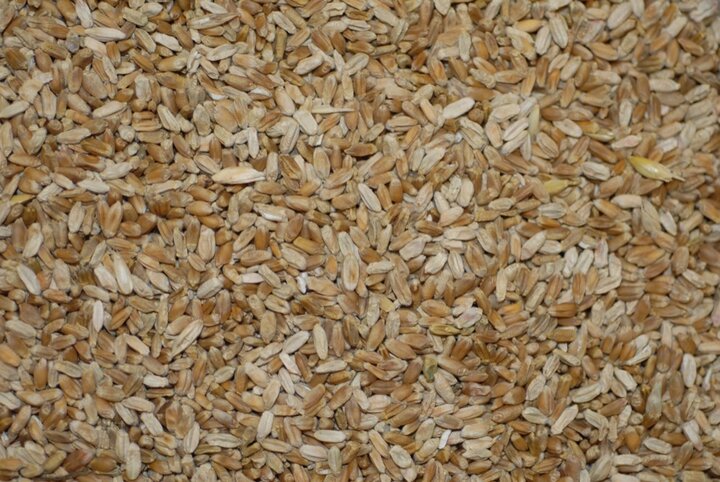
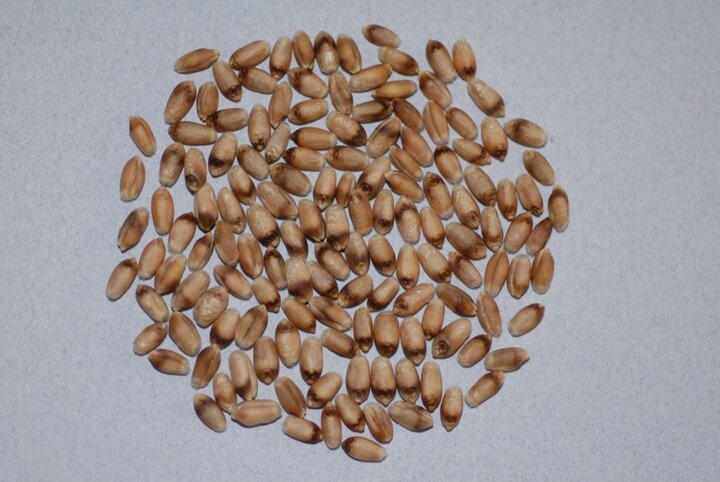
Economic Importance of Seed Transmitted Diseases
Seed transmitted diseases reduce yields as well as grain quality. Grain contaminated by stinking smut can be rejected at the elevator, often resulting in total loss. The pungent odor associated with contaminated grain causes livestock to reject it, significantly reducing its value as a feed. In addition, the compound responsible for the odor, trymethylamine, has potential to cause explosions in combines and elevators when present in high concentrations.
Loose smut does not affect grain quality, but can result in yield losses of up to 40%.
Incidence of ergot in wheat is relatively low. It can cause up to 10% yield loss. In 2011, ergot caused economic losses in south central and southeast Nebraska. Sclerotia or ergots (compact masses of the ergot fungus) can lower grain quality. In addition, the ergots contain toxic alkaloids that can cause ergotism and death in humans and livestock.
Seedling emergence can be reduced by up to 80% if seed heavily infected or contaminated with Fusarium is sown, for example seed from fields affected by Fusarium head blight (scab).
Black point can significantly reduce the bread-making quality of wheat. Heavy contamination of grain with black point can result in discolored flour. This can be a cause for discounting of the grain at the elevator or rejection of the grain by millers. If such grain is used as untreated seed, reduced germination and seedling blights can occur.
Management of Seed Transmitted Diseases
Three strategies can be used in combination to manage seed transmitted fungal diseases of wheat: fungicide seed treatments, use of clean seed, and planting resistant varieties.
Fungicide seed treatments are important for several reasons.
- They control seed transmitted fungal pathogens that may be surface-borne on the seed or internally seed-borne. Additionally, they control soil-borne pathogens such as Bipolaris, Fusarium, Pythium, and Rhizoctonia that cause seedling damping off and root and crown rots. Systemic seed treatments also provide additional protection against fall season foliar fungal diseases.
- In addition to controlling diseases, fungicide-insecticide combination seed treatments also control insect pests such as wireworms, Hessian fly, and fall season aphids.
- By controlling seedling damping off, seed treatments improve stand establishment and result in healthy, vigorous seedlings. Such seedlings build natural defenses that provide additional protection from diseases and insect pests.
It is preferable to buy certified treated seed or have it cleaned and commercially treated. If seed is treated on-farm, it is essential to clean it first before treating. Cleaning seed before treating is especially necessary if the seed transmitted diseases listed above were present in the field during the growing season. For the seed treatment to be effective, ensure thorough, uniform coverage of the seed surface. If possible, use a broad-spectrum systemic fungicide or fungicide-insecticide combination product. For a list of seed treatment fungicides for control of seed transmitted diseases of wheat, see Table I.
Table 1| Trade Name Active Ingredients (%) |
Rate (per 100 lb) |
|---|---|
| LSP Thiabendazole 30.0% |
2.0-4.0 oz |
| Mertect 340-F Thiabendazole 42.3% |
0.17-3.19 oz |
| Charter Triticonazole 2.4% |
3.1 oz |
| Raxil Tebuconazole 28.3% |
0.1 oz |
| Allegiance Dry Metalaxyl 12.5% |
1.5-2.0 oz |
| Allegiance FL Metalaxyl 28.35% |
0.1-0.375 oz |
| Allegiance LS Metalaxyl 17.7% |
1.175-0.66 oz |
| Apron XL Mefenoxam 33.3% |
0.0425-0.085 oz |
| Dyna-Shield Metalaxyl Metalaxyl 28.35% |
0.1-0.375 oz |
| Dyna-Shield Metalaxyl 318 FS Metalaxyl 30.14% |
0.1-0.375 oz |
| Vibrance Sedaxane 43.7% |
0.08-0.16 |
| Vitavax-34 Carboxin 34.0% |
2.0-3.0 oz |
| Dynasty Azoxystrobin 9.6% |
0.153-0.382 oz |
| Dyna-Sield Fludioxonil Fludioxonil 40.3% |
0.08-0.16 oz |
| Maxim 4FS Fludioxonil 40.3% |
0.08-0.16 oz |
| Dithane F-45 Rainshield Mancozeb 37.0% |
1.6 qt/ac |
| Dithane M-45 Mancozeb 80.0% |
2.0 lb |
| Grain Guard Mancozeb 50.0% |
3.3 oz |
| Penncozeb 75DF Mancozeb 75.0% |
2.3-3.5 oz |
| Penncozeb 80WP Mancozeb 80.0% |
2.2-3.3 oz |
| Proceed Metalaxyl 2.75% + Prothioconazole 6.88% + Tebuconazole 1.38% |
1.0-1.5 oz |
| Raxil MD Extra Imazalil 1.0% + Metalaxyl 0.58% + Tebuconazole 0.43% |
5.0 oz |
| Raxil MD Extra-W Imazalil 0.965% + Metalaxyl 0.56% + Tebuconazole 0.415% |
5.14 oz |
| Charter F2 Metalaxyl 0.79% + Triticonazole 1.32% |
5.4 oz |
| CruiserMaxx Cereals Difenoconazole 3.36% + Mefenoxam 0.56% + Thiamethoxam 2.8% (I) |
5.0 oz |
| Dyna-Shield Foothold Metalaxyl 0.668% + Tebuconazole 0.499% |
5.0-6.5 oz |
| Dyna-Shield Foothold Extra Metalaxyl 0.607% + Tebuconazole 0.455% + Imidacloprid 11.374% (I) |
3.4-5.0 oz |
| Dyna-Shield Small Grains Metalaxyl 0.64% + Tebuconazole 0.48% |
5.0-6.5 oz |
| Incentive RTA Difenoconazole 3.21% + Mefenoxam 0.27% |
2.5-10.0 oz |
| NipsIt Suite Cereals Metalaxyl 0.88% + Metconazole 0.44% + Clothianidin 2.93% (I) |
5.0-7.5 oz |
| Rancona Crest Ipconazole 0.421% + Metalaxyl 0.562% + Imidacloprid 14.1% (I) |
5.0-8.33 oz |
| Rancona Pinnacle Ipconazole 0.434% + Metalaxyl 0.579% |
5.0-8.33 oz |
| Raxil MD Metalaxyl 0.64% + Tebuconazole 0.48% |
5.0-6.5 oz |
| Raxil MD-W Metalaxyl 0.615% + Tebuconazole 0.461% + Imidacloprid 1.538% (I) |
5.0 oz |
| Raxil XT Wettable Powder Metalaxyl 20.0% + Tebuconazole 15.0% |
0.16-0.2 oz |
| CruiserMaxx Vibrance Cereals Difenoconazole 3.34% + Mefenoxam 0.86% + Sedaxane 0.72% + Thiamethoxam 2.78% (I) |
5.0-10.0 oz |
| EverGol Energy Metalaxyl 5.74% + Penflufen 3.59% + Prothioconazole 7.18% |
1.0 oz |
| Rancona V RTU FS Carboxin 12.58% + Ipconazole 0.47% + Metalaxyl 1.26% |
4.6 oz |
| Vibrance Extreme Difenoconazole 5.86% + Mefenoxam 1.46% + Sedaxane 1.22% |
2.8-5.6 oz |
| Rancona V 100 Pro FS Carboxin 35.52% + Ipconazole 2.22% |
0.9-1.5 oz |
| Charter PB Thiram 12.5% + Triticonazole 1.25% |
5.5 oz |
| Raxil Thiram Tebuconazole 0.6% + Thiram 20.0% |
3.5-4.6 oz |
| Prevail Carboxin 15.0% + PCNB 15.0% + Metalaxyl 3.12% |
1.5-3.0 oz per bushel |
| Maxim XL Fludioxonil 21.0% + Mefenoxam 8.4% |
0.167-0.334 oz |
| ManKocide Copper Hydroxide 46.1% + Mancozeb 15.0% |
4.0 oz |
Fungicide seed treatments are not effective against ergot. The best strategy for managing this disease is to use certified, pathogen-free seed.
For more information on diseases affecting grain and seed quality in wheat, see EC1872, Distinguishing Between Head Disorders of Wheat.
Resistant varieties, where available, can be used in combination with seed cleaning and seed treatments to more effectively manage seed transmitted diseases of wheat.
Importance of Using Clean, Certified, Fungicide Treated Seed
The importance of using clean, certified, fungicide treated seed cannot be overemphasized. Clean, certified, treated seed optimizes the chances of obtaining high yields. Using farmer-saved or bin-run seed is likely to result in poor variety purity, a low germination percentage, poor stand establishment, and disease, insect, and weed problems. The result will be reduced yield and poor grain quality. Total loss may result if grain is heavily contaminated with fungal spores such as those of the stinking smut fungi. Additional costs may be incurred in treating for diseases, insects, and weeds resulting from use of poor quality seed. In terms of dollars, the return from using clean, certified, treated seed will almost always exceed the cost of the seed. Using clean, certified, treated seed is a form of insurance that is definitely worth the cost.
